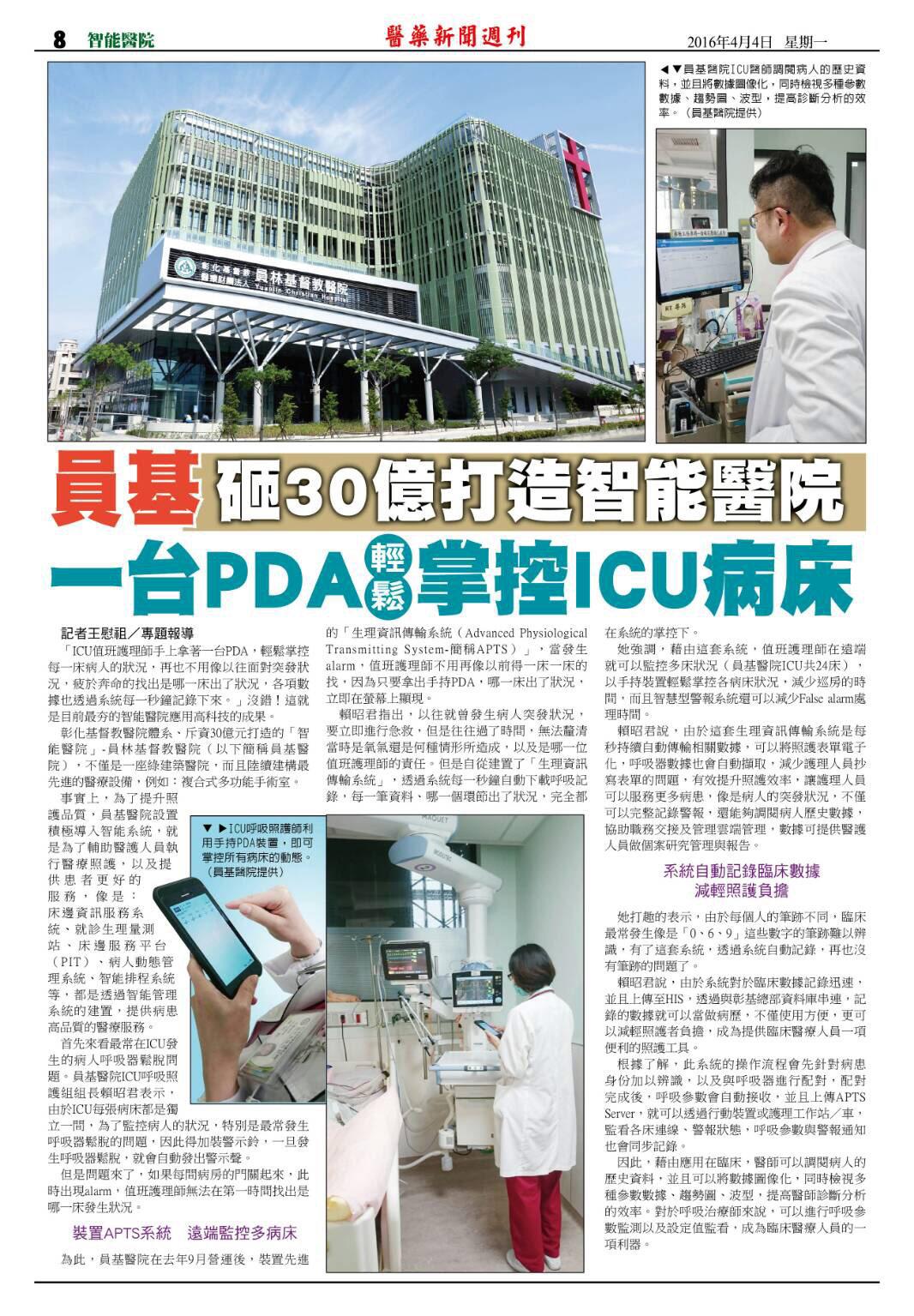Media
Medical News Weekly

"Intelligent Hospital"
"Medical News Weekly"
April 4, 2016, Monday
Yuanlin Changhua Christian Hospital Invests 3 Billion to Build Intelligent Hospital
One PDA Easily Controls ICU Beds
Reporter Wang Weizu / Special Report
Yuanlin Changhua Christian Hospital ICU physicians access patients' historical data, and visualize the data, simultaneously examining various parameter data, trend charts, waveforms, to improve diagnostic analysis efficiency. (The picture above provided by Yuanlin Changhua Christian Hospital)
"ICU respiratory care nurses use handheld PDA devices to easily monitor the dynamics of all beds." (The picture in the middle provided by Yuanlin Changhua Christian Hospital)表單的頂端Reporter Wang Weizu / Special Report
ICU duty nurses now carry a PDA device, effortlessly managing condition of each patient's bed. No longer do they have to scramble to identify which bed is experiencing an issue in the event of an emergency. All data is also recorded by the system every second." That's right! This is the hottest application of high technology in current intelligent hospital."
'INTELLIGENT HOSPITAL,' built with an investment of 3 billion by Changhua Christian Hospital System - Yuanlin Christian Hospital (Hereinafter referred to as YuanGi Hospital), is not only a green building hospital but also gradually constructing the most advanced medical equipment, such as composite multifunctional operating rooms."
In fact, to enhance quality of care, YuanGi Hospital actively integrates intelligent systems to assist healthcare professionals in delivering medical care and providing better services to patients. Systems such as bedside information services, physiological measurement stations, bedside service platforms (PIT), patient dynamic management systems, and intelligent scheduling systems are all implemented through intelligent management systems to provide patients with high-quality medical services.
Let's first look at the most common issue in ICU, which is disconnection of patient's ventilator. Lai Chao-Chun, head of ICU respiratory care team at YuanGi Hospital, explains that since each ICU bed is in an individual room, additional measures are needed to monitor patients, especially for frequency of ventilator disconnection. Therefore, alarms are installed to automatically sound an alert when a ventilator disconnection occurs. However, a problem arises when the doors of each room are closed. At the mean time, if an alarm goes off, the duty nurse may not be able to immediately identify which bed is experiencing the issue.
Installation of Advanced Physiological Transmitting System (APTS) enables remote monitoring of multiple beds simultaneously.
To address this, YuanGi Hospital installed an advanced Physiological Transmitting System (APTS) after its operation in September last year. When an alarm occurs, nurses no longer need to search bed by bed as before. With a handheld PDA, they can immediately see which bed is experiencing an issue displayed on the screen. Lai Chao-Chun pointed out that there were emergencies required immediate intervention in the past. However, it was difficult to determine whether it was an oxygen-related issue or another circumstance, and which nurse should be responsible for it. Since the implementation of Physiological Transmitting System, respiratory records are automatically downloaded every second. Every piece of data and every anomaly are now fully under the system's control.
She emphasized that through this system, nurses can remotely monitor conditions of multiple beds (ICU of YuanGi Hospital has 24 beds totally) and using handheld devices easily helps managing each bed, reducing the time spent on rounds. Additionally, the system can reduce processing time at false alarms.
Lai Chao-Chun explained that since this physiological information transmission system automatically transmits relevant data every second, it can digitize sheets and automatically capture ventilator data, reducing problems of manually writing. This enhances care efficiency, allowing nurses to serve more patients. In the case of emergencies, not only can alarms be fully recorded, but patient historical data can also be accessed in duty handover and cloud management. The data can be used by medical staff for case study management and reporting.
The system automatically records clinical data, alleviating caregiving burden."
She jokingly remarked that since everyone's handwriting is different, it's hard to discern digits like "0, 6, 9" in sheets. With the system, handwriting is no longer an issue.
Lai Chao-Chun mentioned that the system records and uploads clinical data rapidly to Hospital Information System (HIS), which is linked to the database of Changhua Christian Hospital. The data can serve as medical records. This not only enhances convenience but also alleviates the burden on caregivers, becoming a convenient care tool for clinical medical staff.
According to operational workflow of the system, it begins with patient identification and matching with the ventilator. Once matching completes, respiratory parameters are automatically received and uploaded to APTS Server. Medical staff can monitor bed connections, alarm statuses, respiratory parameters, and alarm notifications through mobile devices or nursing workstations/carts. All the information is synchronized and recorded.
By applying the system, physicians can access and visualize patients' historical data in various formats, including parameter data, trend charts, and waveforms. This enhances the efficiency of diagnostic analysis for physicians. For respiratory therapists, they can monitor respiratory parameters and set thresholds, making it a valuable tool for medical staff.
